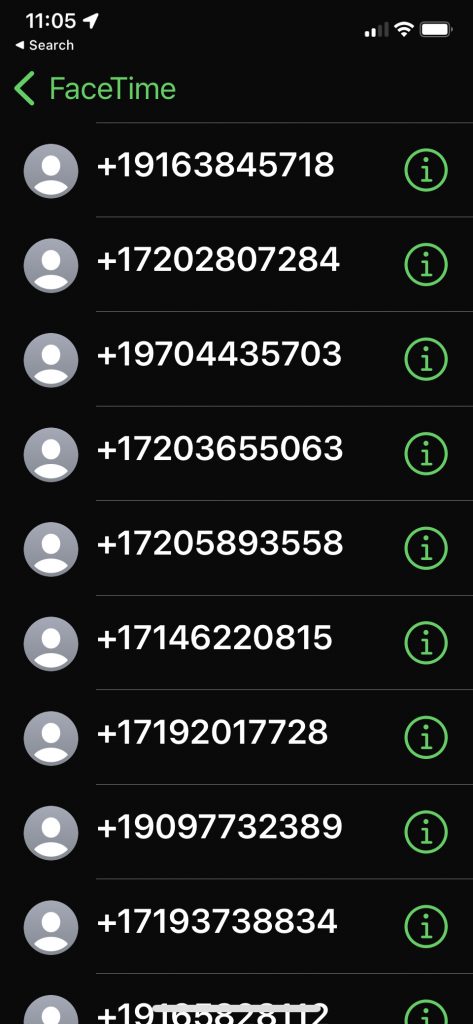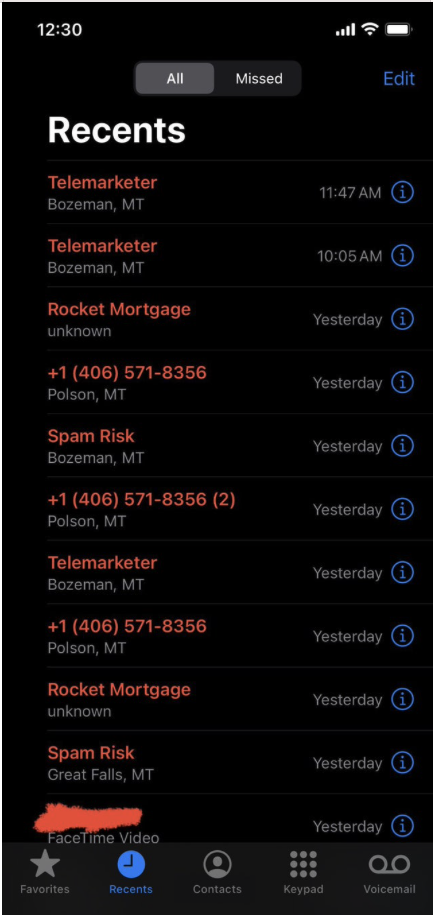Apple’s FaceTime is a lot of fun and lets us keep in touch in ways that were unimaginable just a dozen years ago. As many small business owners shift from dedicated phone lines to multiple cellular phones, scammers keep looking for new tools.
How to Block FaceTime Spam Calls
If you’ve ever received a Facetime Spam Call, you may want to block the number. The real problem is that Spammers exploit FaceTime’s Group FaceTime feature, which allows them to call as many as 31 potential victims at a time. Worse they are now using stolen phone numbers to look like a legit FaceTime Call.
The lack of location book settings on Apple’s products allows wisecrackers to take advantage of Apple’s customers. While clients can impede individual numbers, ignoring FaceTime calls from these numbers won’t stop them from continuing the harassment. You can block individual numbers but these calls can have up to 31 numbers in them.
FaceTime As A Business Tool
FaceTime is becoming a standard tool used by consumers and businesses alike, but is it really suited for business use? If you’re planning a corporate meeting, this video chat might be the ideal tool. FaceTime’s group video chat option is a powerful collaboration tool that enables multiple participants to join a conversation. It could become a viable competitor for Skype for Business and Google Hangouts Chat in the enterprise market. FaceTime group video chat isn’t yet up to a full office Zoom, but it is making Apple a stronger video conferencing and collaboration player.
For our business, we like to be able to talk to our clients and have them use a phone to show us exactly what they are trying to sell. FaceTime gives us a great mobile tool that is very easy to use with end to end encryption. Sometimes clients accidentally share non-disclosure information so that encryptions helps to insure prying eyes are looking in.
However, it’s not clear yet how far Apple will go to expand FaceTime as a business tool. Although the company has not promoted the app as a hybrid hangout tool, it has clearly noticed that its users are increasingly reliant on FaceTime to stay connected. While it might not be the most appropriate tool for all businesses, Apple may be able to capitalize on the social aspect of video conferencing to make it more appealing to business users.
FaceTime for Keeping In Touch
The popularity of FaceTime has increased it’s use by spammers. Spam calls can become a nuisance if you don’t know how to filter them. Whether it’s pranksters calling you from different numbers or a group of strangers trying to sell you something, you shouldn’t engage in these calls. Here are some ways to deal with FaceTime spam:
- Never answer a call from someone you don’t know.
- Make sure to add friends and customers to your contacts
- On the phone, set “silence unknown callers” to on.
- When you get an unknown party call, block all the numbers
Someday hopefully, Apple will extend the silence unknown callers option to FaceTime and iMessages. If I get one more “deal to become a best selling author” text I might toss my phone in the ocean.
If you don’t own an iPhone, you can set up FaceTime on other devices, like an iPad, iPod touch, or Mac. To use FaceTime, you’ll need to enter an email address, but you can change this later. You can’t use your own phone number to sign up for FaceTime. FaceTime works best over WiFi, and you’ll get a better picture when you’re connected to a high-speed connection.
FaceTime as a Scam Tool
A new attack has engulfed FaceTime users. These spammers exploit FaceTime’s group-calling functionality to send out calls and avoid being blocked. Some are pranks, many are scams. After hanging up, the spammers leave an endless stream of callbacks. But, how do you stop these calls from happening to you? Sadly the only answer is to not answer and block the callers.
Ever since the first version of caller id, let you know who was calling, scammers and telemarketers have been looking for new ways around the system. Many telemarketing firms now offshore their call centers so that the laws can be a lot more lax. Some of these FaceTime calls do nothing more than verify your number and add it to yet another list.
FaceTime Call Blocking
If you’ve ever received a large number of unwanted calls via FaceTime, you may want to block these numbers. FaceTime is a great way to share your thoughts with friends, but you probably don’t want to hear from everyone. If you’re tired of receiving unwanted calls, you can block FaceTime callers by following these simple steps. Firstly, open the FaceTime app. The app is green with a white video camera logo. Click on the ‘Block this Caller’ option. Once you’ve done this, the caller’s name will appear in red and you’ll be blocked from further FaceTime conversations with them.
FaceTime call spammers add random numbers to their calls, so it’s very difficult to block them. Moreover, blocking individual numbers from a group call won’t prevent the spammer from adding you to another group call. Fortunately, there are several solutions to FaceTime call blocking. There are numerous apps on the market that can help you block a large number of FaceTime callers. In the case of FaceTime call spam, you must block all of the participants to block all unwanted calls.


Silence Unknown Callers
Someday we hope to block incoming calls from unknown FaceTime callers is by turning on the Silence Unknown Callers setting in your iPhone. When you turn on this feature, only calls from numbers saved in your contacts, recent calls, emails, and texts will ring. As of today this feature doesn’t work for FaceTime calls. Even for the phone, if they leave a message and you don’t delete it, they become a “known caller” and the calls get through. Delete spammy voicemails. If it is about an auto warranty or appliance warranty or a loan, just delete the call history and the voicemail.
You can choose to block FaceTime calls from people you don’t know, but you have to do this one number at a time. Not fun.